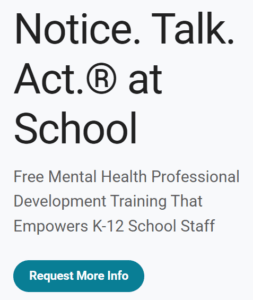Kids' Mental Health Matters: How WE Can Help!!
 In today’s fast-paced world, ensuring the emotional and psychological well-being of our children has never been more important. Mental health is not just about the absence of illness or distress; it’s a crucial building block for a happy, balanced life.
In today’s fast-paced world, ensuring the emotional and psychological well-being of our children has never been more important. Mental health is not just about the absence of illness or distress; it’s a crucial building block for a happy, balanced life.
This service page explores why kids’ mental health matters, how parents and educators can recognize the signs of distress, and the actionable steps brought forward by the American Psychiatric Association’s innovative Notice-Talk-Act at School program. Whether you’re a parent, teacher, or community member, understanding these concepts will empower you to create supportive environments for our youth.
Understanding Kids’ Mental Health
Children are continually growing and absorbing the world around them. Their emotional development is a complex process that is influenced by factors such as their home environment, school experiences, and social interactions.
Mental health in children encompasses a wide range of issues—stress from academic pressures, bullying, family conflicts, or even global events can all impact a child’s ability to thrive. Recognizing that mental health is an integral part of overall health is the first step in fostering positive environments for kids.
This topic is particularly relevant in light of the American Psychiatric Association’s Notice-Talk-Act at School initiative. The program emphasizes a proactive approach that begins with noticing early signs of distress in children, engaging in thoughtful conversations, and taking effective measures to support mental well-being.
 The Importance of Early Recognition
The Importance of Early Recognition
Early identification of mental health challenges can make a significant difference in a child’s life. Children who receive timely support are more likely to overcome difficulties, develop resilience, and excel academically and socially. Parents and teachers, as frontline observers, are uniquely positioned to notice subtle changes in behavior or mood that may indicate distress.
Key indicators include:
- Changes in appetite
- Altered sleep patterns
- Frequent mood swings or irritability
- Loss of interest in activities they once enjoyed
- Social withdrawal or difficulty making friends
By being alert to these signs, adults can initiate conversations that gently address a child’s feelings. If you’re concerned about behavioral changes, consider establishing an open dialogue that does not make the child feel judged or isolated.
The Notice-Talk-Act Approach
The Notice-Talk-Act framework provides a clear roadmap for adults grappling with a child’s mental health concerns. Developed by the American Psychiatric Association, this method encourages a systematic approach:
- Notice – Keep an observant eye on your child’s daily behavior and mood.
- Talk – Initiate a conversation in a supportive and non-confrontational manner.
- Act – Seek professional guidance and implement strategies to help your child regain a sense of normalcy.
This approach reinforces that every small observation and tiny shift in mood matters. Engaging in honest conversations with children about their feelings helps them understand that struggles are a normal part of life and that support is always available.
Creating Supportive Home Environments
A nurturing home environment forms the foundation of good mental health. Parents and caregivers are encouraged to cultivate spaces where children feel secure enough to express their emotions.
Here are some ways to create such an environment:
- Establish a consistent daily routine to provide children with a sense of stability.
- Encourage open discussions about feelings and thoughts without fear of judgment.
- Model healthy emotional responses by managing your own stress and explaining your coping mechanisms.
- Create a designated “quiet time” where children can relax, read, or listen to calming music.
- Celebrate small victories and acknowledge efforts rather than just outcomes.
Incorporating these practices can have a significant impact. For instance, a regular check-in routine, such as a short family meeting during dinner, can serve as a non-formal setting for children to share their fears, achievements, and ideas.
Schools as Mental Health Hubs
In many communities, schools serve as critical hubs for detecting and addressing mental health concerns. The Notice-Talk-Act program has been integrated into school policies to help educators identify early signs of distress among students. By training teachers and staff to recognize behavioral changes, schools can become safe spaces where children receive not only academic support but also emotional guidance.
If you are a teacher or school administrator, consider the following strategies:
- Implement regular classroom check-ins where students are invited to share how they are feeling.
- Create bulletin boards or digital platforms that provide tips on managing stress and anxiety.
- Organize workshops with mental health professionals for both students and staff.
- Develop school-wide events that promote kindness, mindfulness, and solidarity.
- Establish confidential reporting procedures for those who might be struggling in silence.
Integrating multimedia resources—such as videos that explain mindfulness or interactive digital posters—can enhance these initiatives by providing relatable, engaging content for young learners.
Parenting Tips for Promoting Mental Health
The journey towards nurturing mental well-being in children is ongoing and may require different strategies as children grow. Here are some practical parenting tips that can help:
- Open Communication: Create an atmosphere where your child feels free to share feelings. Ask open-ended questions like, “How did that make you feel?” rather than questions that prompt a yes/no answer.
- Validate Emotions: Let your child know it’s okay to feel upset, scared, or frustrated. Phrases like “It sounds like that was really hard for you” can be very empowering for a child.
- Encourage Problem-Solving: Rather than immediately offering solutions, ask your child how they might handle challenges. This empowers them to develop healthy coping strategies.
- Establish Healthy Routines: Regular sleep schedules, balanced diets, and time for both play and relaxation contribute hugely to mental and physical well-being.
- Limit Screen Time: While technology can be a valuable learning tool, too much screen time can amplify feelings of isolation or anxiety.Encourage outdoor play, creative activities, and face-to-face interactions.
Picture this: a family dinner where everyone is encouraged to talk about their day can be much more than just a meal—it can be a daily practice of emotional bonding. A video demonstration showing a family engaging in a conversation about their feelings can provide a relatable tool for families looking to adopt similar practices.
Spotting Stress and Anxiety at Different Ages
Children’s responses to stress and anxiety often differ by age group, which means that awareness efforts need to be age-appropriate. Understanding these variations ensures that adults address concerns effectively. Here’s a brief overview:
 Preschoolers (ages 3-5): At this stage, children may express stress through tantrums, clinginess, or regressive behaviors like thumb-sucking. Simple, age-appropriate explanations about emotions can help.
Preschoolers (ages 3-5): At this stage, children may express stress through tantrums, clinginess, or regressive behaviors like thumb-sucking. Simple, age-appropriate explanations about emotions can help.- Early School Age (ages 6-10): Children might show signs of academic pressure or worries about fitting in with peers. They might also have difficulty sleeping or exhibit stubbornness about routine changes.
- Adolescents (ages 11-18): Teenagers often experience more complex emotions. They may withdraw socially, show signs of depression, or express their distress through risky behaviors or academic decline.
For each age group, catering communication and interventions to the developmental stage of the child is key. For example, interactive games and visual storytelling can be particularly effective with younger children, while teenagers might benefit from one-on-one counseling sessions or peer support groups. Schools and community centers can play an active role by hosting age-specific events or informational sessions.
Community Involvement: A Collective Responsibility

No single entity holds the responsibility for children’s mental health—it’s a communal effort that includes parents, educators, healthcare professionals, and community organizations. When the community comes together, it creates a safety net that ensures every child has someone to turn to in times of crisis.
Consider these steps to foster community involvement:
- Local Collaborations: Schools, parent-teacher associations, and local health clinics can host seminars and workshops featuring mental health experts.
- Peer Groups: Establish peer support groups where children can meet in a safe, moderated environment to share their experiences and support one another.
- Awareness Campaigns: Organize events like mental health fairs or mural projects, where art and expression become a medium for discussing feelings and overcoming stigma.
- Resource Sharing: Create a centralized resource hub on community websites where parents and educators can access reliable information, advice, and contact directories for professional help.
Practical Strategies in the Classroom
Educators are on the frontlines when it comes to recognizing and addressing mental health challenges in children. Here are some practical strategies that teachers and school staff can integrate into everyday classroom activities:
- Mindfulness Techniques: Begin the day with a short mindfulness exercise, such as guided breathing, to help students center themselves.
- Safe Spaces: Designate a corner of the classroom as a “quiet zone” where students can take a break if they feel overwhelmed.
- Emotional Check-Ins: Use visual aids like emoticon charts to help students indicate how they feel at various points during the day.
- Collaborative Learning: Group projects do not just enhance academic skills; they also foster teamwork and social interaction.
- Regular Feedback: Provide both positive reinforcement and constructive feedback in a way that respects each child’s feelings and efforts.
Access to Professional Support
Sometimes, professional intervention is necessary. While everyday strategies and community support play a vital role, children with more significant mental health challenges may require specialized care. It is crucial to recognize when to seek  help beyond the home or school environment.
help beyond the home or school environment.
Consider the following indicators that professional support might be needed:
- Persistent sadness or irritability lasting more than a few weeks
- Sudden changes in behavior or academic performance
- Self-harming behaviors or talk of self-harm
- Extreme withdrawal from friends and family
- Excessive anxiety that disrupts daily functioning
If any of these signs become apparent, it’s important not to delay seeking help. Contact your pediatrician, school counselor, or a child psychologist to arrange a professional evaluation.
Many communities now offer telehealth sessions, making it easier than ever to access mental health experts from the comfort of your home.
For those seeking a deeper dive into professional support options, a downloadable guide outlining steps to find a child-focused mental health professional can provide additional clarity and peace of mind.
Integrating the Notice-Talk-Act Program into Daily Life
While systemic approaches in schools and communities are essential, parents and caregivers can also adopt the principles of the Notice-Talk-Act program in day-to-day interactions. Here are some actionable steps for integrating these principles at home:
 Notice:
Notice:
⮚ Observe your child’s reactions during and after stressful events, such as an exam or a conflict with friends.
⮚ Keep a simple journal where you note down any recurring changes in behavior or mood.- Talk:
⮚ Initiate gentle, heartfelt discussions at opportune moments, such as during a bedtime routine.
⮚ Use open-ended questions and reflective listening to help your child feel understood. - Act:
⮚ If patterns of distress emerge, consider scheduling a session with a professional counselor.
⮚ Work collaboratively with your child to create coping strategies that suit their personality and needs.
These everyday steps not only strengthen the child-parent bond but also foster resilience and self-awareness in children. Reminding children that expressing their feelings is a sign of strength rather than weakness can have lasting positive impacts on their mental health.
Looking to the Future: Cultivating Resilience
The ultimate goal of any mental health initiative is to empower children to face life’s challenges with resilience. Building resilience requires a blend of self-awareness, emotional intelligence, and practical coping strategies. Encourage your child to:
- Develop hobbies and interests that nurture their creativity and provide a positive outlet for their emotions.
- Engage with peers in activities that foster teamwork and collective problem-solving.
- Learn from setbacks by reflecting on what they can do differently next time.
- Understand that challenges are opportunities for growth rather than insurmountable obstacles.
When children begin to see challenges as part of the human experience and realize that resilience can be built through practice and dedication, they are better prepared for the future.
A Call to Action for Parents, Educators, and Communities
 Kids’ mental health is a collective responsibility that transcends the boundaries of home, school, and healthcare. From noticing the initial signs of distress to engaging in open conversations and taking decisive action, every step counts. If you’re a parent looking for support, an educator aiming to foster a healthier classroom environment, or a community leader seeking to build a network of resources, the path is clear: notice, talk, and act.
Kids’ mental health is a collective responsibility that transcends the boundaries of home, school, and healthcare. From noticing the initial signs of distress to engaging in open conversations and taking decisive action, every step counts. If you’re a parent looking for support, an educator aiming to foster a healthier classroom environment, or a community leader seeking to build a network of resources, the path is clear: notice, talk, and act.
We invite you to explore our resources, participate in our webinars, and join our community efforts dedicated to enhancing kids’ mental health. Whether you need expert advice or simply want to learn more about creating supportive environments for children, you can reach out to us today.
Together, we can ensure that every child enjoys the positive mental health they deserve.
In conclusion, kids’ mental health matters, not just because it affects their performance at school but because it defines the quality of their lives. With initiatives such as the Notice-Talk-Act at School program leading the way, parents, educators, and communities now have a robust framework to support our children. Let’s take the journey together—toward understanding, support, and empowerment.
Remember, every observation counts. Every conversation matters. And every act of kindness builds a resilient future for our children. If you have concerns about your child’s mental well-being or need further guidance, please do not hesitate to contact APAF. They are here to help, support, and ensure that the mental health of our next generation is in safe, caring hands.
Empower your child. Act today for a brighter tomorrow.
Listen on Podcast
Did you like your experience?
Please leave us a Testimonial HERE if you have a Google account.
Your word helps get our word out to more people.
Thank you in advance!!


